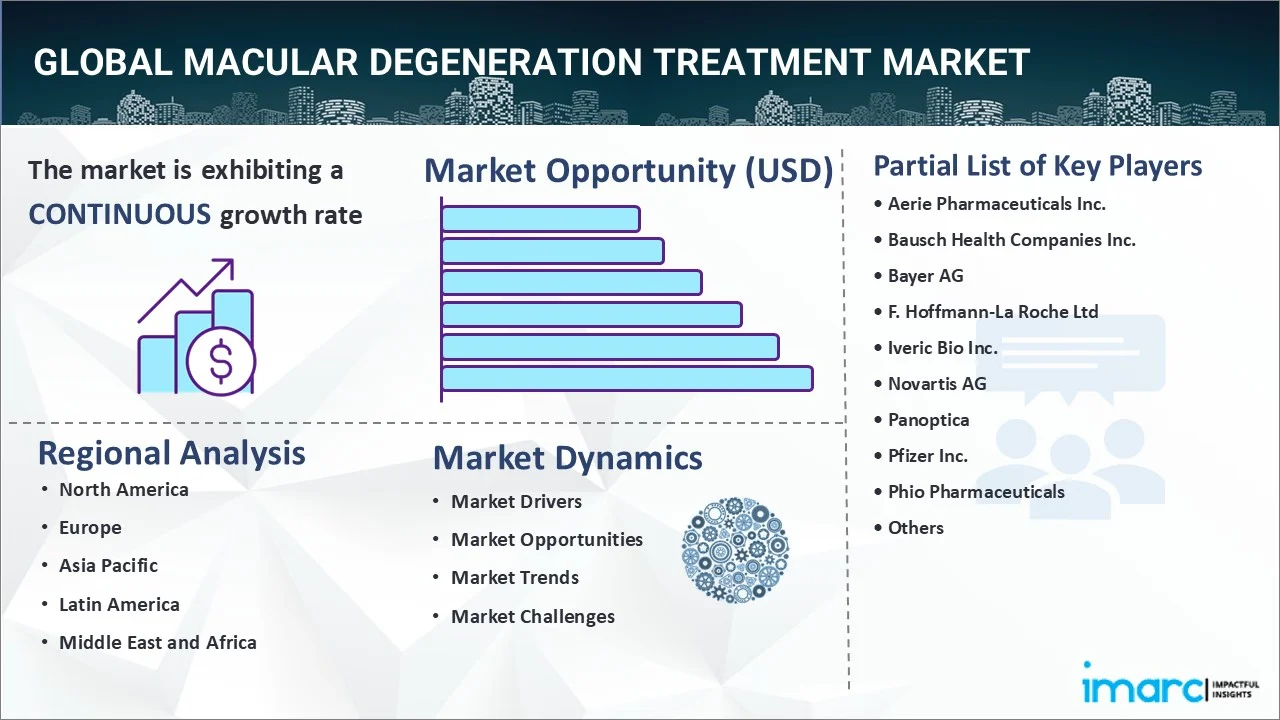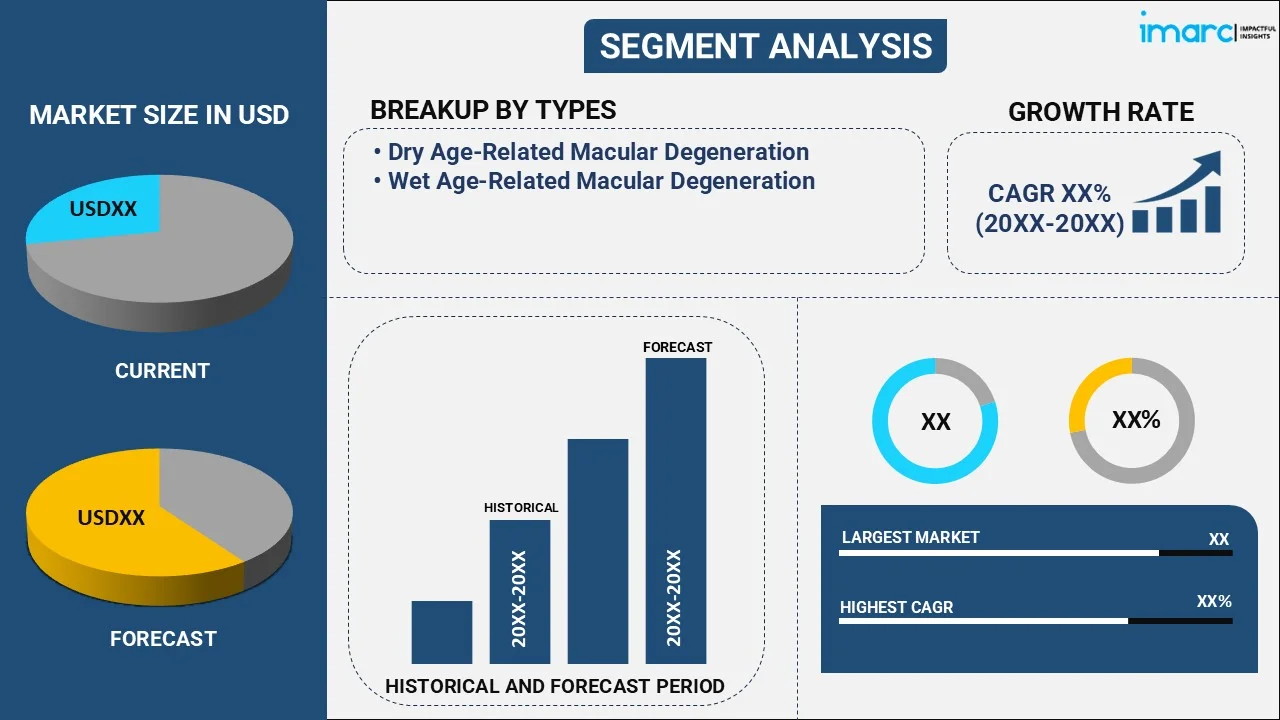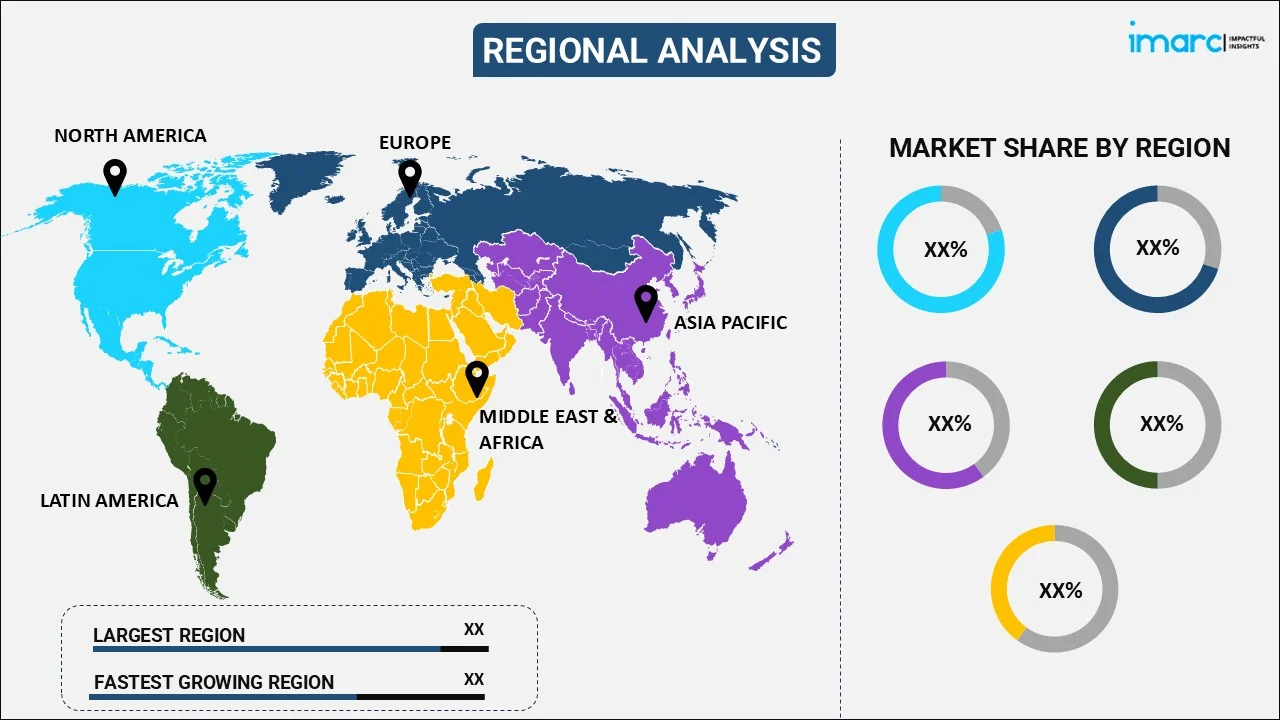
Macular Degeneration Treatment Market Report by Type (Dry Age-related Macular Degeneration, Wet Age-related Macular Degeneration), Stage of Disease (Early Stage, Intermediate Stage, Late Stage), Route of Administration (Intravenous Route, Intravitreal Route), End User (Hospitals, Ambulatory Surgical Center, and Others), and Region 2025-2033
Macular Degeneration Treatment Market Size:
The global macular degeneration treatment market size reached USD 9.9 Billion in 2024. Looking forward, IMARC Group expects the market to reach USD 15.8 Billion by 2033, exhibiting a growth rate (CAGR) of 5.28% during 2025-2033. The market is majorly driven by the increasing incidences of age-related macular degeneration and obesity among the masses, growing prevalence of sedentary lifestyles, rapid utilization of smart devices, and significant improvements in the healthcare infrastructure, particularly in developing economies.
|
Report Attribute
|
Key Statistics
|
|---|---|
|
Base Year
|
2024
|
|
Forecast Years
|
2025-2033
|
|
Historical Years
|
2019-2024
|
|
Market Size in 2024
|
USD 9.9 Billion |
|
Market Forecast in 2033
|
USD 15.8 Billion |
| Market Growth Rate 2025-2033 | 5.28% |
Macular Degeneration Treatment Market Analysis:
- Major Market Drivers: The increasing prevalence of macular degeneration, especially among the aging population, is a primary market driver. Advances in diagnostic techniques and treatment modalities are also contributing significantly. Rising awareness and early diagnosis initiatives further fuel the market expansion.
- Key Market Trends: There is a notable shift towards biologics and gene therapy in the treatment of macular degeneration. Minimally invasive procedures and innovative drug delivery systems are gaining traction. Personalized medicine and tailored treatment approaches are becoming increasingly prevalent. This, in turn, is creating a positive macular degeneration treatment market overview.
- Geographical Trends: North America leads the market due to high healthcare spending and advanced medical infrastructure. Europe also shows substantial growth owing to increased research funding and an aging population. Asia-Pacific is further emerging as a lucrative market due to rising healthcare investments and a growing patient pool.
- Competitive Landscape: Some of the key market players include Aerie Pharmaceuticals Inc., Bausch Health Companies Inc., Bayer AG, F. Hoffmann-La Roche Ltd, Iveric Bio Inc., Novartis AG, Panoptica, Pfizer Inc., Phio Pharmaceuticals, Regeneron Pharmaceuticals Inc., Regenxbio Inc. and Santen Pharmaceutical Co. Ltd.
- Challenges and Opportunities: High treatment costs and limited access to advanced therapies pose significant challenges in the market. However, ongoing research and development present opportunities for novel treatments. Expansion into emerging markets and technological advancements in treatment methods offer potential for future growth.

Macular Degeneration Treatment Market Trends:
Increasing research and development (R&D) activities
Extensive R&D efforts are being focused on creating medications that target specific biochemical pathways involved in macular degeneration, such as anti-VEGF therapies that prevent aberrant blood vessel formation. These medications not only improve visual outcomes, but they also increase treatment intervals, which improves patient convenience and compliance. Furthermore, technical advancements like as sustained-release drug delivery systems and gene therapy provide great promise for long-term management and potential solutions. Collaboration among academics, pharmaceutical corporations, and biotech enterprises creates a fertile ground for breakthroughs, thereby bolstering the macular degeneration treatment market outlook.
Growing burden of retinal disorders
The rising prevalence of retinal illnesses is contributing to the market expansion. For example, according to a research article published in the British Journal of Ophthalmology in August 2020, age-related macular degeneration (AMD) is the leading cause of vision impairment and blindness in Europe. Age-related macular degeneration (AMD) affects around 67 million people in Europe, and this figure is anticipated to rise by 15% by 2050 as the population ages. According to data, the growing number of people suffering from retinal problems correlates closely with the market growth. Thus, the rising prevalence of such conditions is driving the market during the macular degeneration treatment market forecast period.
Rising geriatric population
The growing geriatric population around the world is likely to drive the global market over the forecast period. The prevalence of retinal diseases rises with age. AMD is the most common cause of blindness in developed countries, especially among individuals over the age of sixty. According to the World Health Organization (WHO), in 2019, the number of people aged 60 years and older was 1 billion. This is expected to create a positive outlook for the market and increase the macular degeneration treatment market revenue.
Macular Degeneration Treatment Market Segmentation:
IMARC Group provides an analysis of the key trends in each segment of the market, along with forecasts at the global, regional, and country levels for 2025-2033. Our report has categorized the market based on type, stage of disease, route of administration, and end user.
Breakup by Type:

- Dry Age-related Macular Degeneration
- Wet Age-related Macular Degeneration
Wet age-related macular degeneration dominates the market
The report has provided a detailed breakup and analysis of the market based on the type. This includes dry and wet age-related macular degeneration. According to the report, wet age-related macular degeneration represented the largest segment.
The global macular degeneration treatment market report shows that wet age-related macular degeneration category dominated the global market. Wet AMD is treated with intravitreal injections (IVT), and an estimated 22.3 million operations were performed worldwide in 2017. Approximately 75% of anti-VEGF injections were administered to treat wet AMD. The effectiveness of these treatments, combined with advances in diagnostic technologies, continues to enhance access and therapeutic outcomes for patients suffering from wet AMD. The high prevalence of the condition, branded drugs, more awareness, and an increase in the number of therapies for wet AMD are all contributing to the segment's dominance in the macular degeneration treatment market share.
Breakup by Stage of Disease:
- Early Stage
- Intermediate Stage
- Late Stage
Late stage holds the largest share in the market
A detailed breakup and analysis of the market based on the stage of disease have also been provided in the report. This includes early stage, intermediate stage, and late stage. According to the report, late stage accounted for the largest market share.
The late stage of macular degeneration has a substantial impact on the market. As the disorder progresses, individuals experience severe vision impairment. The necessity to treat this illness fuels research and interest in these treatments. Pharmaceutical corporations are motivated to develop drugs and treatments, resulting in more advanced treatment options. Furthermore, given the critical need for treatments in the late stages of the illness, medical professionals and patients are more willing to accept novel therapy, regardless of cost. This dynamic supports macular degeneration treatment market growth and advancement for these treatments.
Breakup by Route of Administration:
- Intravenous Route
- Intravitreal Route
Intravitreal route holds the maximum share in the market
A detailed breakup and analysis of the market based on the route of administration have also been provided in the report. This includes intravenous route and intravitreal route. According to the report, intravitreal route accounted for the largest market share.
The intravitreal route is a critical driver in the market. This strategy considers designated treatment, lessening fundamental secondary effects, and working on quiet results. The rising prevalence of age-related macular degeneration and diabetic retinopathy enhances the interest in intravitreal routes. Headways in drug plans and conveyance procedures further improve the allure of this route. Furthermore, the intravitreal administration's demonstrated adequacy in clinical trials upholds its adoption by ophthalmologists, thus fueling the macular degeneration treatment demand.
Breakup by End User:
- Hospitals
- Ambulatory Surgical Center
- Others
Hospitals hold the maximum share in the market
A detailed breakup and analysis of the market based on the end user have also been provided in the report. This includes hospitals, ambulatory surgical center, and others. According to the report, hospitals accounted for the largest market share.
Hospitals play an important role in providing a boost to the market. Their excellent diagnostic capabilities and specialized care facilities appeal to patients seeking complete eye care. They also provide a platform for the implementation of cutting-edge technologies and therapies, which improve patient outcomes. Collaboration between hospitals and pharmaceutical companies speeds up the development of new medications and treatment methods. Furthermore, the emphasis on quality care and patient management in hospitals increases demand for effective macular degeneration therapies, which contributes significantly to market expansion.
Breakup by Region:

- North America
- United States
- Canada
- Asia-Pacific
- China
- Japan
- India
- South Korea
- Australia
- Indonesia
- Others
- Europe
- Germany
- France
- United Kingdom
- Italy
- Spain
- Russia
- Others
- Latin America
- Brazil
- Mexico
- Others
- Middle East and Africa
North America leads the market, accounting for the largest macular degeneration treatment market share
The market research report has also provided a comprehensive analysis of all the major regional markets, which include North America (the United States and Canada); Asia Pacific (China, Japan, India, South Korea, Australia, Indonesia, and others); Europe (Germany, France, the United Kingdom, Italy, Spain, Russia, and others); Latin America (Brazil, Mexico, and others); and the Middle East and Africa. According to the report, North America represents the largest regional market for macular degeneration treatment.
North America dominated the market with the highest revenue share and the presence of a large number of major macular degeneration treatment companies. This dominance can be attributed to the rising prevalence of AMD. According to the American Academy of Ophthalmology, around 15 million individuals in North American live with AMD. There is also a high prevalence of macular degeneration in the region, which is expected to rise in the coming years. Furthermore, the growing geriatric population and disease burden are also propelling the market. The favorable government initiatives to support the affordability of costly anti-VEGF products are expected to contribute to the market growth.
Competitive Landscape:
The market research report has provided a comprehensive analysis of the competitive landscape. Detailed profiles of all major companies have also been provided. Some of the key players in the market include:
- Aerie Pharmaceuticals Inc.
- Bausch Health Companies Inc.
- Bayer AG
- F. Hoffmann-La Roche Ltd
- Iveric Bio Inc.
- Novartis AG
- Panoptica
- Pfizer Inc.
- Phio Pharmaceuticals
- Regeneron Pharmaceuticals Inc.
- Regenxbio Inc.
- Santen Pharmaceutical Co. Ltd.
(Please note that this is only a partial list of the key players, and the complete list is provided in the report.)
Frequent approvals and launches of novel medications by key players are resulting in macular degeneration treatment market recent developments. Increased investments in R&D are pivotal for the development of effective treatments. Notably, companies are investing in genetic medicines and the development of novel drugs such as anti-VEGF (Vascular Endothelial Growth Factor) therapies. For example, in October 2021, Roche announced that the Food and Drug Administration (FDA) had approved Susvimo (100 mg/mL ranibizumab injection) to treat wet, or neovascular, age-related macular degeneration (AMD), a disease that can cause rapid and severe vision loss. Also, there's a notable trend of mergers, acquisitions, and partnerships among key players aiming to consolidate market presence and enhance their product portfolios. Companies are also focusing on expanding their reach in high-growth regions such as Asia-Pacific, where the increasing geriatric population and government initiatives to improve healthcare accessibility is favorably impacting the market. Apart from this, some of the macular degeneration treatment market recent opportunities include leveraging state-of-the-art technologies for enhancing patient outcome by various major players and the introduction of AI-powered imaging and analytics for improving the accuracy of diagnoses and enabling personalized treatment plans.
Macular Degeneration Treatment Market News:
- September 28, 2023: Bayer AG announced that it will present new aflibercept 8 mg 60-week and 96-week data for patients with neovascular (wet) age-related macular degeneration and diabetic macular edema.
- July 8, 2024: F. Hoffmann- La Roche Ltd. announced to reintroduce Susvimo in the US for individuals with neovascular age-related macular degeneration (nAMD). The FDA has approved updates to Susvimo, which will be available to US retina specialists and patients with nAMD in the coming weeks. Susvimo offers the first alternative to regular eye injections that are standard of care for nAMD, which impacts 20 million people worldwide and can cause blindness if left untreated.
- August 19, 2023: IVERIC bio, Inc. announced that the U.S. Food and Drug Administration (FDA) has completed its filing review and accepted the company’s New Drug Application (NDA) for avacincaptad pegol (ACP), a novel investigational complement C5 inhibitor for the treatment of geographic atrophy (GA) secondary to age-related macular degeneration (AMD).
Macular Degeneration Treatment Market Report Scope:
| Report Features | Details |
|---|---|
| Base Year of the Analysis | 2024 |
| Historical Period | 2019-2024 |
| Forecast Period | 2025-2033 |
| Units | Billion USD |
| Scope of the Report | Exploration of Historical Trends and Market Outlook, Industry Catalysts and Challenges, Segment-Wise Historical and Future Market Assessment:
|
| Types Covered | Dry Age-Related Macular Degeneration, Wet Age-Related Macular Degeneration |
| Stage of Diseases Covered | Early Stage, Intermediate Stage, Late Stage |
| Route of Administrations Covered | Intravenous Route, Intravitreal Route |
| End Users Covered | Hospitals, Ambulatory Surgical Center, Others |
| Regions Covered | Asia Pacific, Europe, North America, Latin America, Middle East and Africa |
| Countries Covered | United States, Canada, Germany, France, United Kingdom, Italy, Spain, Russia, China, Japan, India, South Korea, Australia, Indonesia, Brazil, Mexico |
| Companies Covered | Aerie Pharmaceuticals Inc., Bausch Health Companies Inc., Bayer AG, F. Hoffmann-La Roche Ltd, Iveric Bio Inc., Novartis AG, Panoptica, Pfizer Inc., Phio Pharmaceuticals, Regeneron Pharmaceuticals Inc., Regenxbio Inc., Santen Pharmaceutical Co. Ltd., etc. |
| Customization Scope | 10% Free Customization |
| Post-Sale Analyst Support | 10-12 Weeks |
| Delivery Format | PDF and Excel through Email (We can also provide the editable version of the report in PPT/Word format on special request) |
Key Benefits for Stakeholders:
- IMARC’s industry report offers a comprehensive quantitative analysis of various market segments, historical and current market trends, market forecasts, and dynamics of the macular degeneration treatment market from 2019-2033.
- The research report provides the latest information on the market drivers, challenges, and opportunities in the global macular degeneration treatment market.
- The study maps the leading, as well as the fastest-growing, regional markets. It further enables stakeholders to identify the key country-level markets within each region.
- Porter's five forces analysis assists stakeholders in assessing the impact of new entrants, competitive rivalry, supplier power, buyer power, and the threat of substitution. It helps stakeholders to analyze the level of competition within the macular degeneration treatment industry and its attractiveness.
- The competitive landscape allows stakeholders to understand their competitive environment and provides insight into the current positions of key players in the market.
Key Questions Answered in This Report
The global macular degeneration treatment market was valued at USD 9.9 Billion in 2024.
We expect the global macular degeneration treatment market to exhibit a CAGR of 5.28% during 2025-2033.
The rising incidences of age-related macular degeneration and obesity, along with the increasing adoption of macular degeneration treatment in enhancing vision and minimizing the risks of developing chronic blindness, are primarily driving the global macular degeneration treatment market.
The sudden outbreak of the COVID-19 pandemic had led to postponement of elective treatment for neurodegenerative ocular disorder to reduce the risk of coronavirus infection upon hospital visits or interaction with healthcare professionals.
Based on the type, the global macular degeneration treatment market has been segmented into dry age-related macular degeneration and wet age-related macular degeneration. Currently, wet age-related macular degeneration holds the majority of the total market share.
Based on the stage of disease, the global macular degeneration treatment market can be divided into early stage, intermediate stage, and late stage. Among these, late stage currently exhibits a clear dominance in the market.
Based on the route of administration, the global macular degeneration treatment market has been categorized into intravenous route and intravitreal route, where intravitreal route accounts for the largest market share.
Based on the end user, the global macular degeneration treatment market can be segregated into hospitals, ambulatory surgical center, and others. Currently, hospitals hold the largest market share.
On a regional level, the market has been classified into North America, Asia-Pacific, Europe, Latin America, and Middle East and Africa, where North America currently dominates the global market.
Some of the major players in the global macular degeneration treatment market include Aerie Pharmaceuticals Inc., Bausch Health Companies Inc., Bayer AG, F. Hoffmann-La Roche Ltd, Iveric Bio Inc., Novartis AG, Panoptica, Pfizer Inc., Phio Pharmaceuticals, Regeneron Pharmaceuticals Inc., Regenxbio Inc., and Santen Pharmaceutical Co. Ltd.
Need more help?
- Speak to our experienced analysts for insights on the current market scenarios.
- Include additional segments and countries to customize the report as per your requirement.
- Gain an unparalleled competitive advantage in your domain by understanding how to utilize the report and positively impacting your operations and revenue.
- For further assistance, please connect with our analysts.
 Inquire Before Buying
Inquire Before Buying
 Speak to an Analyst
Speak to an Analyst
 Request Brochure
Request Brochure
 Request Customization
Request Customization




.webp)




.webp)












